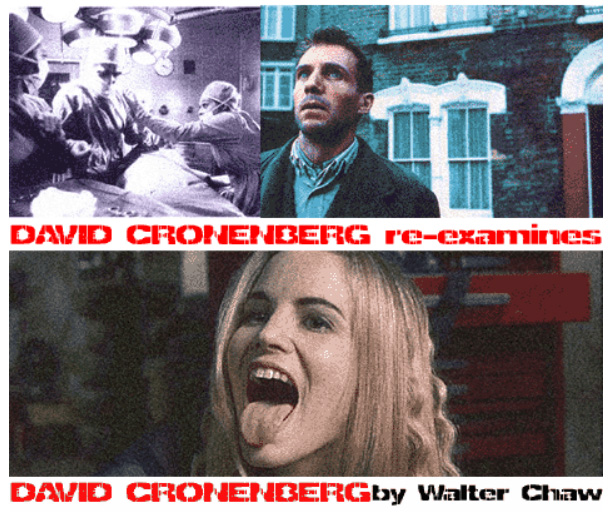GRAY’S ANATOMY
**½/**** Image A- Sound B Extras B
directed by Steven Soderbergh
A PERSONAL HISTORY OF THE AMERICAN THEATER
***½/****
directed by Skip Blumberg
AND EVERYTHING IS GOING FINE
****/**** Image N/A Sound B Extras A
directed by Steven Soderbergh
SEX AND DEATH TO THE AGE 14
***/****
directed by Dan Weissman and Brad Ricker
by Walter Chaw The first ten minutes of Steven Soderbergh’s Gray’s Anatomy are obnoxious, and though there are few artists as interesting to me or as influential in my own life as Spalding Gray, the last 109 don’t exactly blow my skirt up, either. Let me back up. I tripped over Swimming to Cambodia in English class, Freshman year, then procured my own copy at Boulder’s invaluable The Video Station so that I could go back to it and, sure, impress Liberal Arts girls with it on a double-bill with Stop Making Sense. You might say that Gray and David Byrne were my wingmen for a couple of years there; it’s fitting that my VHS copies of both those pieces are now and forever in the possession of ex-girlfriends and love interests. I wonder if I would ask for the tapes back were I to run into them again. I know that one of them, after I was married, tried to return Swimming to Cambodia, and I asked her to please keep it. If you don’t know what Swimming to Cambodia is, it’s Spalding Gray’s unbelievably great performance-“monolog” about his time on set, on location, shooting Roland Joffe’s The Killing Fields. I’ve never heard Joffe speak, but I have Gray’s impersonation of Joffe–calling out to a tripping-balls Gray, floating in shark-infested surf in the South China Sea–lodged in my brain. I pull it out once in a while at a party, just as a sonar ping to see if anyone could possibly identify the echo of the echo.
Jonathan Demme shoots Swimming to Cambodia in a minimal way that nonetheless suggests movement and imparts tension. It’s brilliant. Indescribably brilliant. I hope Criterion or someone else who cares enough eventually gives it the kind of treatment the lesser Gray’s Anatomy has now received. Gray’s Anatomy is another of Gray’s monologs (like Monster in a Box and Terrors of Pleasure), filmed this time by Steven Soderbergh in a way that lodges midway between Errol Morris and Demme but is hamstrung by the comparisons. Gray’s a captivating speaker, of course, a man for whom the term “spellbinding” fits without hyperbole, but starting with those first ten minutes, this one never strikes the right balance between showcasing Gray’s unique talents and not appearing as though it’s trying too hard. That prologue says a lot. It features a series of man-on-the-street interviews in which various people talk about their eye trauma. Squirm-inducing in a Lucio Fulci sort of way, it goes on for far too long and is too self-conscious about its purpose. It’s the problems of the film in précis, in other words, and if you were to come to it without at least having seen Swimming to Cambodia, you would have entirely the wrong introduction to Gray. Yes, what he does is the quintessence of solipsistic–but the way he does it, captured correctly, is a fascinating amalgam of theatre and the possibilities of film.
Gray’s Anatomy is about a “pucker” that appears on Gray’s eye as he’s writing the portion of his novel dealing with his mother’s suicide. When he talks about this in this 1996 picture, if you know anything about Gray’s sad end, you should get a little jolt. Gray, five years later, incurs a misdiagnosed head injury in a bad car accident that causes him great suffering, both physical and existential. He saw Oliver Sacks about it. He was on the mend. He was working on a monologue called “Life Interrupted” and had workshopped it in front of adoring audiences, who watched him recover the form captured in Gray’s Anatomy, at least a little bit. In 2004, after buying his Revolutionary War-obsessed son a history book, he disappeared. It was worse, because in all his many previous attempts at and promises of suicide, he’d left a note behind, or a message on a machine. Something. This time, nothing. They recovered his body off a riverbank. Unlike the father in Big Fish, the last movie Gray saw, he didn’t turn into a fish when he walked into the water, but in the mind of his then-wife, that Tim Burton film had given him “permission to die.” When I watch Gray in Gray’s Anatomy, two things: first, I know that while this story is full of references to his lost Renee, he has in fact already left his eponymous psychotherapist wife Renee Shafransky for talent agent Kathie Russo, with whom he’d fathered a child in 1993 (three years prior to filming this monolog); second, I am completely incapable of looking at his hands in the same way I’ve heard that med students, entering gross anatomy for the first time, have the most trouble dissecting the genitals and, yes, hands of their cadaver subjects. For whatever reason, although the entire film is essentially Gray front and centre, it’s his hands that represent to me the totality of his loss.
Anyway, Gray’s Anatomy is Gray’s odyssey through potential blindness from a mysterious ailment. It recounts his phobias and his avoidance of treatment, and, as he and only he, really, is able to do in this medium he’s invented, ties everything that happens to him into a tapestry that somehow enfolds a world of coincidence, synchronicity, and wonder. He’s the classic intellectual nihilist, but the real magic of his performance is his ability to locate the thread–the slipstream–of the collective unconscious. Though he invokes Freud, Gray, not just in his words but in his presentation as well, is a poet of Jung’s party. I don’t believe him, needless to say, when he says in the middle of his talk that he doesn’t even like poetry. That’s like Tom Waits saying he doesn’t like music. It’s a terrible shame that Soderbergh interjects fragments of other interview subjects, and that he bookends Gray’s monologue with snapshots in the Errol Morris style. It’s a terrible shame that he gets very showy with his lighting and tracking shots in a way that magnifies, but doesn’t clarify, Demme’s picture. It is haunting, though. How could it not be, when the last lines of the monolog are “Ecstasy, despair, ecstasy, despair” and some mention of a big fish?
A surprise treat, The Criterion Collection’s Blu-ray edition of Gray’s Anatomy also houses A Personal History of the American Theater, a monolog written and performed by Gray in 1980 as part of his Wooster Group. It was filmed at the Performing Garage on November 28th, 1982. At feature-length (97 mins.) and apparently uncut, it presents the artist in the wild in a vintage video that looks almost exactly like I remember PBS looking as a child. In it, an impossibly young Gray discourses on the plays he’s been in and offers his thoughts on miscasting and misadventure. The audience laughs when he mentions his mother seeing him in a play in the midst of “an incurable nervous breakdown,” because I suspect the audience doesn’t know that his mother’s killed herself. I wonder at this moment if it’s ever possible to appreciate Gray in a vacuum again. “Three Penny Opera” and “Under Milkwood” (“I used to like Dylan Thomas until I was involved in three productions of “Under Milkwood”) are among the works cited, and throughout the gimmick, if you can call it that (better “mnemonic”), a series of placards with the titles of plays on them seems to inspire in him spontaneous reverie. It’s his gift that I can’t tell whether this entire performance was scripted or if his mnemonic is genuine.
I love his discussion of “The Curious Savage” for his thoughts on being committed to an asylum. I love that “Period of Adjustment” inspires him to talk not only about how this is Tennessee Williams’s metaphor for marriage, but also about the difficulties of speaking with a southern accent and a stutter at a community theatre in Cape Cod. I love how he believed that Donald Ritchie was maybe an idiot because he laughed at everything and therefore “didn’t know what was funny…he had no gestalt to him.” “Antigone” finds him recalling his excitement at being in a chorus he describes as just like Donald Duck’s nephews, which strikes me as maybe the smartest thing I’ve ever heard about classic Disney and the appeal of classic animated shorts to the animal brain. I can’t begin to tell you how much I love this document. I wish that Gray weren’t dead. I also wonder if he wouldn’t resonate like he does had he not died the way he did, and suffered along the way. It’s terrible, I know.
Released simultaneously by Criterion (and making its home-video debut), Soderbergh’s And Everything is Going Fine is a portrait of Gray’s life, six years after his death and seventeen after Soderbergh and Gray’s first collaboration. It’s a feature-length montage of footage from Gray’s performances (mostly shot by hand-held camcorders, it appears)–almost all delivered to captive and appreciative audiences–and absolutely indispensable as a history. At roughly the half-hour mark, he’s there, young still (circa Swimming to Cambodia, if I had to guess) and recounting his mother’s suicide, how his father got together with a woman down the street whose husband, the same night his mother took her own life, drank himself to death. There’s something–more than something–of John Irving to him (more neurotic); moreover, something of Thomas Pynchon. John Cheever? Armistead Maupin? Studs Terkel? I couldn’t admire Gray more. There are television appearances (including one from the halcyon days of MTV), long-form interviews, and, most amazingly, home movies from the last years of his life where he’s on crutches from his crushed hip and speaking mordantly of his role now as witness and “half dead.” He talks about his accident in the way he’s able to talk about things (“We spent one erotic night and then the next morning, boom…there was cow medicine everywhere”), and it’s as painful to listen to and watch as it is astonishing that I should feel this kind of connection to someone I never met, and never will.
Criterion’s And Everything is Going Fine platter unearths another gratifying addition to the Gray canon: the complete Sex and Death to the Age 14, Gray’s first monolog. The piece is lighter, whimsical, more obviously crowd-pleasing and more in love with wordplay and rhythms. Maybe his statement that he hates poetry comes from this early singsong, and I realize as I write this that I’m beginning to engage in theatre critique rather than film criticism. Whatever. The monolog as a document is again a rare treasure, even if the work itself is clearly green and raw. You see where this could go if he kept up with it. Thank God he did.
THE BLU-RAY DISCS
Gray’s Anatomy receives a flawless 1.85:1, 1080p transfer, though the source is minimally challenging: ultra-grainy during the black-and-white interstitials; crystalline but stagebound otherwise. Colours are vivid and impactful, contrast is rich, and definition is crisp. The attendant 5.1 DTS-HD MA track is utterly adequate–liner notes inform us that long-time Soderbergh collaborator Larry Blake spruced up the original audio by remixing Cliff Martinez’s score in surround sound. Three HD interviews constitute the bulk of supplementary material. Recorded in March, 2012, a Soderbergh talking-head (12 mins.) explains the importance of this film for him in recapturing the fertility of an imagination that had gone fallow after four features. He briefly discusses the eight-day shoot before moving on to how he came to Gray through his novel Impossible Vacation, leading Soderbergh to cast him in King of the Hill. Soderbergh says the reason he pulled in other interviews was just to stretch Gray’s monologue to a feature-length. He also wanted to experiment with infrared film, so…voilà! I want to be clear, it isn’t that I disrespect Soderbergh’s desire to escape from formalism, only that I wish he’d better succeeded. Gray’s death is not one of the subjects covered. More on that later.
Next up, Shafransky (18 mins.), whose interview is prefaced with a clip of Gray reminiscing about the filming of Swimming to Cambodia–how the original monologue was 3½ hours and how Demme asked him to cut that down to the “perfect moment.” Shafransky reflects on her collaborations with Gray, and indeed she receives a co-writing credit on Gray’s Anatomy. She remembers her surprise at Gray’s ability to walk out on stage so composed. And she touches on that Gray-preferred spelling of the word, “monolog”–one part solitary, the other part memoir. That makes perfect sense. This is, let’s be frank, absolutely vital material and mostly new. Thank you, Criterion. Rounding out the platter, the original theatrical trailer, plus “Swimming to the Macula”, sixteen uncomfortable minutes of actual footage from Gray’s macular pucker surgery (upconverted, like A Personal History of the American Theater and Sex and Death to the Age 14, to 1080i)–silent because, really, what do you say? If you hang around after the end credits, by the way, there’s a fun post-script. Amy Taubin writes extended liner notes that aren’t that revelatory but do provide a nice introduction to the main feature on the disc.
And Everything is Going Fine receives a 1.33:1, 1080i transfer that’s only ever as good as the source materials will allow. Aurally, Blake has done a fine job of leeching maximum fidelity from disparate recordings and recording methods, and the impressive result is rendered in an uncompressed centre-channel mix. Special features begin with “The Making of And Everything is Going Fine” (21 mins., HD), in which Russo and editor Susan Littenberg join Soderbergh to discuss more explicitly Gray’s last days. I’m stunned by the revelation that Russo believes 9/11 was the real snapping point for Gray. I’m touched, too, by Soderbergh’s confession that he made this film as a kind of penance for being a “bad friend” who avoided Gray following his accident for no other reason than that he didn’t know how to deal with that level of injury. Russo gave Soderbergh complete access to Gray’s archives, 20+ years of transcribed journals, photographs, and videotapes most crucially, culled from just televisually around 90 hours of stuff. Littenberg touches on some of the technical challenges of the film and Soderbergh’s love of imperfection–and his understanding that in crafting a documentary of Gray’s work and life, the only thing that truly mattered is the clarity of the sound. It makes me reassess the failure of Gray’s Anatomy in a different way. It’s not better, but I understand it better. A trailer for the film rounds out the BD, while Nell Casey, the editor of Gray’s published journals, writes the booklet essay. It’s good.
- Gray’s Anatomy
115 minutes; NR; 1.85:1 (1080p/MPEG-4); English 5.1 DTS-HD MA; English SDH subtitles; BD-50; Region A; Criterion - And Everything is Going Fine
89 minutes; NR; 1.33:1 (1080p/MPEG-4); English 1.0 LPCM; English SDH subtitles; BD-50; Region A; Criterion

![Gray's Anatomy (The Criterion Collection) [Blu-ray]](https://m.media-amazon.com/images/I/41tbj8QZ72L._SL500_.jpg)

![And Everything is Going Fine (The Criterion Collection) [Blu-ray]](https://m.media-amazon.com/images/I/41qP3shh5aL._SL500_.jpg)

![The Rocky Horror Picture Show (1975) + Shock Treatment (1981) [Bodice-Ripping Fabulous 3-Disc Set] - DVD 6a0168ea36d6b2970c017ee3d3e4d7970d](https://filmfreakcentral.net/wp-content/uploads/6a0168ea36d6b2970c017ee3d3e4d7970d.jpg)




Thank you so, so much.